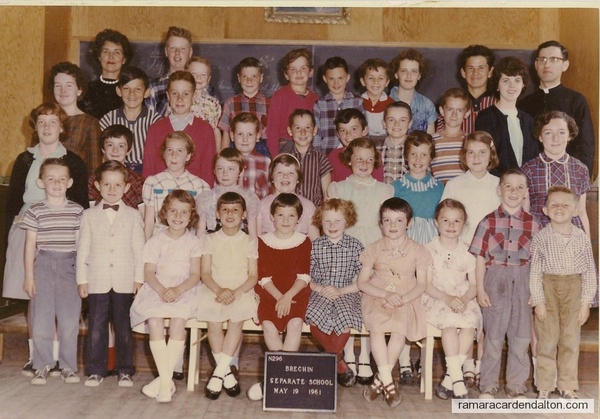True or False
Article from Lindsay Post 1983
Reseached by Frances Laver
.
UPHILL
Post Vision Lindsay November 29, 1983
THIS YEAR UPHILL DISAPPEARS FROM THE MAP
By Anita Snyder
Indians, lumberjacks and small farms lend Uphill a legacy of hard work and wild stories.
The Longford Lumber company which lasted for approximately 20 years from 1867, made Uphill a thriving village with general stores, blacksmith shops, a church, a school and of course , hotels.
Alvin Adams, a lifetime resident of the village said some people say” lumberjacks were wilder than the Indians,” whom he used to wait on the high grounds for people to come down the Black River.
On the corners of Highway 503 and 505, stands the old house that acted as a boarding house for the men. It has been fully renovated since then of course and is owned by Mac and Elaine Dickson. A doorway that leads from the kitchen to the living room still bears the imprint of a lumberjack’s heavy boots.
WHERE THE BONES ARE BURIED
There is no cemetery in Uphill and the residents remember stories of lumberjacks being buried along the river. Occasionally, bone remains are found of past villagers, in yards or fields and stories passed down over the century tell where the remains are located.
Adams tells of a story he heard about an old proprietor of the North Star Hotel, which used to be located on Highway 505, just south of 503. The story says that the proprietor kicked his wife down the stairs and buried her out back. No one knows if he was ever charged for the incident, but they do know approximately where she was buried.
“In a way, I guess you could call it a ghost town,” said Dickson.
The North Star Hotel features many stories, some of which are documented in the book, The Land Between. From 1876 to 1902 the North Star was the only tavern in the entire municipality. John Calhoun operated it until 1884 when it was rented to William Richardson. In 1887, Dan McKinnon took over but “he was his own best customer and happened to be inebriated one day when the inspector called. His license was promptly cancelled.”
One of the blacksmiths of the village, George Stephens, was another great patron of the hotel. It is written that “many a night he was trundled home along the Monck Road in a wheelbarrow. Mr. Adams said his uncle had his first drink of beer at that hotel at the age of 16
NO TREES, NO PATRONS
When the lumbering operations moved out of the area, business at the hotel began to slow down and by 1902 its doors were closed for good. The building was used as a residential home for some time after and was torn down in 1941.
By the late 1800’s the timber was being rapidly cleaned up and the main scene for operations for the company branched into Quarrying and ranching in the south.
The Uphill property became headquarters for the Digby Ranching Company which raised beef cattle and shipped them mainly to the United States.
In about 1904 or 1905, a man named McGrimmon, the manager of the ranch drove 150 head of cattle to Orillia where he loaded them on a train for ST. Paul. McGrimmon went with them and collected the money for the cattle but he was never seen again. To do things up right, he also took along another man’s wife and was never seen again either. This was the end of the Digby Ranching Company. Since that time, the land has been used for farming.
FEW BUILDINGS REMAIN
St. Andrew’s Presbyterian Church was erected in 1893 on the northwest corner of Highways 505 and 503. Prior to the building of the church, services were held five times a year in the schoolhouse and had an average attendance of 30 people. Services in the church lasted only until 1927 and except for a brief period when Baptist missionaries used it from 1933 to 1936, the building remained empty for years. It was torn down in 1941, never to be rebuilt.
Uphill’s school opened the wooden doors of an empty log house to students in 1862. In 1882 a proper log school was put up in Digby, on Highway 505 just south of Highway 503. Bee Cathcart, another lifetime resident of Uphill received education in that school.
“We used to hide in the vacant blacksmith shop at recess” said Mrs. Cathcart, laughing at the memory of trying to skip class. “When the recess bell rang to go back to school, we wouldn’t go back but when we got scared and after five minutes, we went running back to school.”
The school was closed down in June 1943 and is now torn down. Come to think of it every old business or social centre in Uphill is torn down, along with many old farm houses. Now when you drive up Highway 505 past Victoria Road, you wind through a densely wooded area. If you walked through the woods you may find rhubarb patches or lilac trees or even the foundations of the old farms of times gone by. As you pass through 3 kilometers of windy wooded road, you will break through a cover of trees and see a little blue sign that says Uphill. Ahead of you will only be a handful of well kept residences and no inclination of the prosperous village that used to be almost a century ago.
And keep that 1988 road map because next year Uphill will only have a ghost like presence on the official road map at the junction of the two highways. The word Uphill will not appear..
.
Note:
